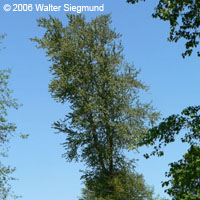First ever tree genome sequenced
For the first time, the genome of a tree has been sequenced. The tree in question is a type of poplar known as the black cottonwood (Populus trichocarpa). Sequencing the poplar genome of 485 million base pairs (the building blocks of DNA) took four years and involved over 100 scientists in 38 institutions spread across Europe, Canada and the US. Their findings are reported in the latest edition of the journal Science. Forests cover almost a third of the Earth's surface, and are home to a significant proportion of the planet's biodiversity. Trees also provide humanity with a range of important services, ranging from clean air and water to materials for construction, furniture, fibre, paper and fuel. While the poplar is the first tree to be sequenced, it is not the first plant; that honour fell to Arabidopsis thaliana, a type of cress widely used in plant research, whose genome was sequenced in 2000. In 2002, the genome of the rice plant - staple food for more than half the world - was sequenced. However, as the researchers note, trees face very different challenges to these short-lived plants. 'Their need to survive and thrive in fixed locations over centuries under continually changes physical and biotic stresses also sets them apart from short-lived plants,' they write. The poplar was chosen because of its relatively small genome compared to other trees, its fast growth rate, the relative ease of experimental manipulation and the range of genetic tools available. Poplars are also economically important trees; poplars, 'can reach reproductive maturity in as few as four to six years, permitting selective breeding for large-scale sustainable plantation forestry,' write the researchers. It also has great potential for conversion into biofuels. The researchers identified over 45,000 possible genes on the poplar's 19 chromosomes. The researchers also compared the poplar's genes with those of Arabidopsis thaliana. The evolutionary lineages of these two plants split some 100-120 million years ago. The differences between the genomes principally concern genes involved in disease resistance, growth, metabolic transport and the synthesis of the cell wall. The work has a number of possible applications. The team was able to identify 93 genes involved in the production of cellulose, hemicellulose and lignin, the building-blocks of plant cells walls. Cellulose and hemicellulose are also the raw materials for bio-ethanol production. Unfortunately getting at these raw materials while they are locked up in the plant's cell walls is incredibly difficult. Researchers, including a team at Ghent University in Belgium, now plan to investigate the genes involved in the production of the cell wall and see if they could be modified to make the cellulose and hemicellulose more accessible.
Countries
Belgium, Canada, Germany, Greece, Finland, France, Sweden, United Kingdom, United States



